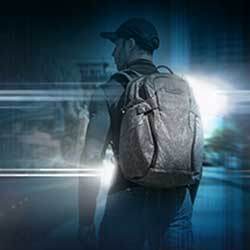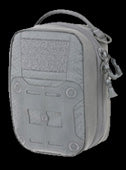Many tragic yet avoidable deaths in the outdoors are attributed to prolonged exposure. With one wrong turn, a casual day hike can become the ultimate nightmare. Being lost or hurt and unable to endure the elements long enough before help arrives can result in the unprepared adventurer paying the ultimate price. Therefore, being ready now with essential equipment and survival skills will help you and your family enjoy the great outdoors with peace of mind.
To present the essentials of outdoor survival to our user community, we engaged Thomas Coyne, an experienced first responder turned survival school owner / chief instructor to host the inaugural season of our new video series “Maxpedition Survival Tips.”
In Season 1, Coyne takes a Maxpedition Riftcore™ backpack loaded with survival equipment into the mountains of Southern California to demonstrate the skills needed during unplanned, extended stays in the wilderness. By watching these videos, you will learn how to construct a shelter, build a friction fire, purify water, and bandage open wounds. Whether you find yourself suddenly lost and/or hindered by an injury, these basic yet crucial skills can make the difference between life or death.
To protect against natural forces such as wind, rain, or snow, shelter is imperative. In Episode 1, Thomas Coyne demonstrates how to construct an A-frame or tripod shelter that can be built by one person from just found forest materials. He has affixed onto his belt the Rollypoly MM Folding Dump Pouch, from which he retrieves his gloves for handling abrasive raw materials. The bright orange handle of his fixed blade knife can also be seen within, easily accessible for cutting foliage, trimming wood, etc.
After forming a bed with the immediately surrounding vegetation, Coyne establishes the tripod foundation for this all-weather shelter by interlocking three large sticks, one of which is forked. He continues taking several more large sticks acting as frame poles and distributes them along the sides, making sure to maintain a forty-five degree angle or steeper to help shed rain or snow. Over that he adds latticework and covering, made from numerous forked branches and pine needles, respectively. A key takeaway from constructing this type of shelter is its strength and durability. It does not collapse when Coyne straddles the center or after placing his fully packed Riftcore™ on top.
Now that you have a shelter to protect you against inclimate weather, it’s important to maintain warmth, as temperatures can drop dramatically at night. If you built your shelter in front of a large boulder or rock wall, having a fire in between will bounce the heat off that solid surface, keeping you surrounded by a pocket of warm air. Moreover, you may also need fire to heat your MRE or cook wild game. Coyne carries his fire starting tools in his Maxpedition FRP™ First Response Pouch, but should you not be prepared with such supplies, knowing how to make a friction fire is a necessary alternative.
Coyne describes how to create a Bow & Drill Friction Fire in episode 2. Easily produced in most forests, the main components are the bow, drill, baseboard or hearth, and a drill socket, all of which he elaborates on in the video. To begin making his friction fire, he drills a pilot hole into the baseboard, after which he cuts a notch into it. He then resumes drilling into the baseboard, the notch now acting as a catch that eventually collects burning dust created by friction into an ember. From there, he transports the ember onto his tinder and blows air gently until the ember ignites the fuel into a fire.
Opposite fire is water, and needless to say water is fundamental to human survival. It is generally understood that a person can go approximately three weeks without food, but only days without water. The end could be hastened should the water be contaminated and induce fatal illness. Getting sick in the middle of nowhere is less than ideal, therefore purifying contaminated water you find in the outdoors is an essential safety measure. Dangerous protozoa such as Cryptosporidium and Giardia, the two most common microorganisms that infest wild waters, can be effectively eliminated with chemical tablets and a filter. As seen in episode 3, Coyne packs both in his FRP™ First Response Pouch (thoughtfully referred to as his "Maxpedition kit"). Taking things a step further, he also has them in his LBP™ Large Expandable Bottle Pouch which accommodates a stainless steel water bottle and a five liter portable reservoir - altogether acting as a complete wilderness water purification system. This is a good example of how Maxpedition's wide range of pouches and attachments allow users to adapt their kits to meet different mission objectives.
With the stainless steel bottle, you can also treat water through boiling. For proper disinfection, you’ll want a rolling boil at sea level for one minute and add an additional minute for every one-thousand meters gained in elevation. The five liter portable reservoir also serves as a pre-treatment container for scooping up water and dissolving chemical tablets; chlorine and iodine being the only two recommended by the Center for Disease Control. Because neither of these are 100% effective, one must use chemical tablets combined with a filter. Coyne demonstrates this and places his tabs in a reservoir attached to his filter, waiting the allotted period of time for the chemical to take full effect, and confidently taking a drink of water collected from a southern California stream.
In just about any given outdoor activity, disaster can strike unexpectedly and cause injury to you or a member of your party. Understanding how to tend to injuries when professional medical support isn't immediately available will help prevent the injury from worsening and maximize chances of survival. In episodes 4 & 5, Thomas Coyne teaches how to clean and bandage a wound in addition to creatively making an arm sling out of a shemagh. He has splayed out an impeccably packed Maxpedition LTB™ Lightweight Toiletry Bag, containing a comprehensive first-aid survival kit. The bag’s design enables optimal organization for Coyne's essential medical supplies.
When dealing with an open wound, controlling bleeding and preventing infection takes priority. The first step is cleaning the wound, which Coyne advises can be accomplished with irrigation methods utilizing a sterile saline wound wash. In the absence of said item, you may use a plastic water bottle with a hole on punched in the lid and squeeze its contents out. The added pressure cleans the wound. Afterwards, disinfect and apply a sterile dressing. Secure the dressing with a tight bandage, wrapping with a twist over the wound for increased pressure, before finally securing with several pieces of waterproof medical tape.
Sustained injuries to the hand, wrist, arm and shoulder may require immobilization as to inhibit further damage or pain. You can manipulate a shemagh (also called a keffiyeh) to yield an improvised arm sling. Have the injured person maintain his or her arm in the position of function, which mimics the pledge of allegiance posture. Taking the shemagh, form a large triangle and tuck in one point to the center. Then place the injured person’s arm into the center and proceed to tie the remaining ends around the back. For further security, swathing the sling will restrain the limb from unwanted excess movement.
At the end of the day, having tools and supplies will make all of the above attainable. Be prepared and pack extra MREs, a hatchet for wood cleaving, first aid supplies for medical emergencies, etc. Furthermore, don’t just drop them all in a bag. Organize and know where everything is located. Fumbling through a pile of gear, useful or not, is wasted time that could mean life or death in critical situations.
For episode 5, Thomas Coyne showcases his Maxpedition Riftcore™ backpack and how he customizes it for survival training in the mountains of California or the rough terrains of Alaska. The MOLLE attachment affixed to his shoulder strap is the RDP™ Radio Pouch, which houses his radio for maintaining communication with his instructors. Secured to the front is a DES™ Double Sheath Pouch, conveniently carrying a tactical light and knife. He continues and revisits the FRP™ First Response Pouch and the LBP™ Large Expandable Bottle Pouch mentioned earlier.
Thomas Coyne is able to navigate hazardous terrain relying solely on his strength and his skills - in fact he has, once hiking through Death Valley taking only a knife and a hat. However, unless you're an extreme thrill seeker, there's little sense in venturing out unprepared. Coyne trusts Maxpedition because he understands the importance of durable and dependable gear out in the field not just for himself, but for all prepared citizens.
With experience in Fire & Rescue, EMT Helicopter Rescue, Confined Space Rescue, Swift Water Rescue, and more, he has founded Coyne Survival Schools with emphasis on making students their own personal first responder. His school has become a respected and reliable source of instruction, trusted by the U.S. Navy Helicopter Search & Rescue & Special Warfare, U.S. Air Force Special Operations, the U.S. Department of Defense, and more. In Episode 6, Coyne delves into his background and explains his passion for survival.
Experts such as Thomas Coyne stress the necessity of everyday and outdoor preparedness. As more “Maxpedition Survival Tips” come into development, many more experts from a variety of professional backgrounds will candidly share real, practical advice. Stay informed when new episodes are available and be sure to subscribe to Maxpedition’s Youtube channel. You can also join the mailing list for first looks at new products, upcoming videos and awesome discounts.
About Coyne Survival Schools:
https://www.californiasurvivaltraining.com
"We are here to get you ready for the real thing. All courses are led by former first responders and veterans. Our training is not based on what you'll find in all the same old survival manuals or YouTube videos. It's based on real world experience, in extreme climates and terrains- globally. This is why 3 branches of the United States Military have chosen us for a wide range of training, and we hope you and your family (yes we have training for all ages and skill levels) do as well."











